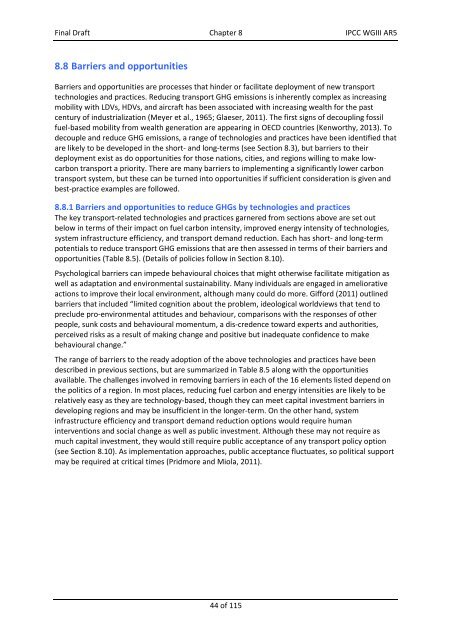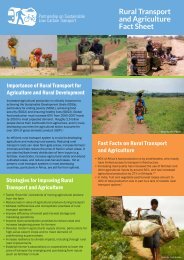ipcc_wg3_ar5_final-draft_postplenary_chapter8
ipcc_wg3_ar5_final-draft_postplenary_chapter8
ipcc_wg3_ar5_final-draft_postplenary_chapter8
You also want an ePaper? Increase the reach of your titles
YUMPU automatically turns print PDFs into web optimized ePapers that Google loves.
Final Draft Chapter 8 IPCC WGIII AR5<br />
8.8 Barriers and opportunities<br />
Barriers and opportunities are processes that hinder or facilitate deployment of new transport<br />
technologies and practices. Reducing transport GHG emissions is inherently complex as increasing<br />
mobility with LDVs, HDVs, and aircraft has been associated with increasing wealth for the past<br />
century of industrialization (Meyer et al., 1965; Glaeser, 2011). The first signs of decoupling fossil<br />
fuel‐based mobility from wealth generation are appearing in OECD countries (Kenworthy, 2013). To<br />
decouple and reduce GHG emissions, a range of technologies and practices have been identified that<br />
are likely to be developed in the short‐ and long‐terms (see Section 8.3), but barriers to their<br />
deployment exist as do opportunities for those nations, cities, and regions willing to make lowcarbon<br />
transport a priority. There are many barriers to implementing a significantly lower carbon<br />
transport system, but these can be turned into opportunities if sufficient consideration is given and<br />
best‐practice examples are followed.<br />
8.8.1 Barriers and opportunities to reduce GHGs by technologies and practices<br />
The key transport‐related technologies and practices garnered from sections above are set out<br />
below in terms of their impact on fuel carbon intensity, improved energy intensity of technologies,<br />
system infrastructure efficiency, and transport demand reduction. Each has short‐ and long‐term<br />
potentials to reduce transport GHG emissions that are then assessed in terms of their barriers and<br />
opportunities (Table 8.5). (Details of policies follow in Section 8.10).<br />
Psychological barriers can impede behavioural choices that might otherwise facilitate mitigation as<br />
well as adaptation and environmental sustainability. Many individuals are engaged in ameliorative<br />
actions to improve their local environment, although many could do more. Gifford (2011) outlined<br />
barriers that included “limited cognition about the problem, ideological worldviews that tend to<br />
preclude pro‐environmental attitudes and behaviour, comparisons with the responses of other<br />
people, sunk costs and behavioural momentum, a dis‐credence toward experts and authorities,<br />
perceived risks as a result of making change and positive but inadequate confidence to make<br />
behavioural change.”<br />
The range of barriers to the ready adoption of the above technologies and practices have been<br />
described in previous sections, but are summarized in Table 8.5 along with the opportunities<br />
available. The challenges involved in removing barriers in each of the 16 elements listed depend on<br />
the politics of a region. In most places, reducing fuel carbon and energy intensities are likely to be<br />
relatively easy as they are technology‐based, though they can meet capital investment barriers in<br />
developing regions and may be insufficient in the longer‐term. On the other hand, system<br />
infrastructure efficiency and transport demand reduction options would require human<br />
interventions and social change as well as public investment. Although these may not require as<br />
much capital investment, they would still require public acceptance of any transport policy option<br />
(see Section 8.10). As implementation approaches, public acceptance fluctuates, so political support<br />
may be required at critical times (Pridmore and Miola, 2011).<br />
44 of 115



